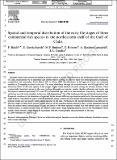Por favor, use este identificador para citar o enlazar a este item:
http://hdl.handle.net/10261/325092COMPARTIR / EXPORTAR:
 SHARE SHARE
 CORE
BASE CORE
BASE
|
|
| Visualizar otros formatos: MARC | Dublin Core | RDF | ORE | MODS | METS | DIDL | DATACITE | |

| Título: | Spatial and temporal distribution of early stages of three commercial fish species in the north eastern shelf of the Gulf of Cadiz |
Autor: | Baldó, Francisco CSIC ORCID ; García-Isarch, Eva; Jiménez, María Paz; Romero, Zeneida; Sánchez-Lamadrid, A.; Catalán, Ignacio Alberto CSIC ORCID | Palabras clave: | Pesquerías Ichthyoplankton Centro Oceanográfico de Cádiz Fish eggs Fish larvae Multivariate analysis Engraulis encrasicolus Sardina pilchardus Dicologlossa cuneata |
Fecha de publicación: | 2006 | Citación: | Deep-Sea Research II ], II (53). 2006: 1391-1401 | Resumen: | Monthly cruises were carried out during an annual cycle in a coastal fringe located at the northeastern shelf of the Gulf of Ca´ diz, characterised by its important and diverse fishery activity, in order to study the ichthyoplankton abundance, composition and seasonality. From March 2002 to March 2003, the abundance of fish eggs and larvae was estimated monthly at 26 sampling stations in the area. The mean abundance through the analysed period was 955 eggs/100m3 and 326 larvae/100m3 of the total species of fish caught. Higher mean densities occurred during the warmest months. Three commercially important species in the area (anchovy Engraulis encrasicolus, sardine Sardina pilchardus and wegde sole Dicologlossa cuneata) represented 57% and 50% of mean fish eggs and larval concentrations, respectively. Anchovy eggs and larvae were the most abundant in the area, each representing 33% of the total mean fish egg and larval concentrations. Temporal variations in the abundance of eggs and larvae showed different reproduction patterns for the analysed species: while anchovy reproduction mainly occurred during the spring–summer period, sardine reproduced during autumn–winter whereas wedge sole was mainly winter–spring spawner in the area. Furthermore, the spatial distribution was different for the early stages of these three species. Cluster analysis of the sampling stations (based on Bray–Curtis similarities derived from the annual mean concentrations of eggs and larvae of the three species) revealed four well-defined areas: a coastal western sector, a coastal eastern sector, an offshore sector and a single sampling station, close to the Guadalquivir River mouth, which showed a high degree of accordance with the oceanographic characterisation of the area. r 2006 Published by Elsevier Ltd. | URI: | http://hdl.handle.net/10261/325092 | DOI: | 10.1016/j.dsr2.2006.04.004 |
| Aparece en las colecciones: | (IEO) Artículos |
Ficheros en este ítem:
| Fichero | Descripción | Tamaño | Formato | |
|---|---|---|---|---|
| Pág 1 deep-sea R. 2006.pdf | 70,45 kB | Adobe PDF |  Visualizar/Abrir |
CORE Recommender
SCOPUSTM
Citations
43
checked on 07-may-2024
WEB OF SCIENCETM
Citations
36
checked on 22-feb-2024
Page view(s)
12
checked on 15-may-2024
Download(s)
17
checked on 15-may-2024
Google ScholarTM
Check
Altmetric
Altmetric
Este item está licenciado bajo una Licencia Creative Commons

